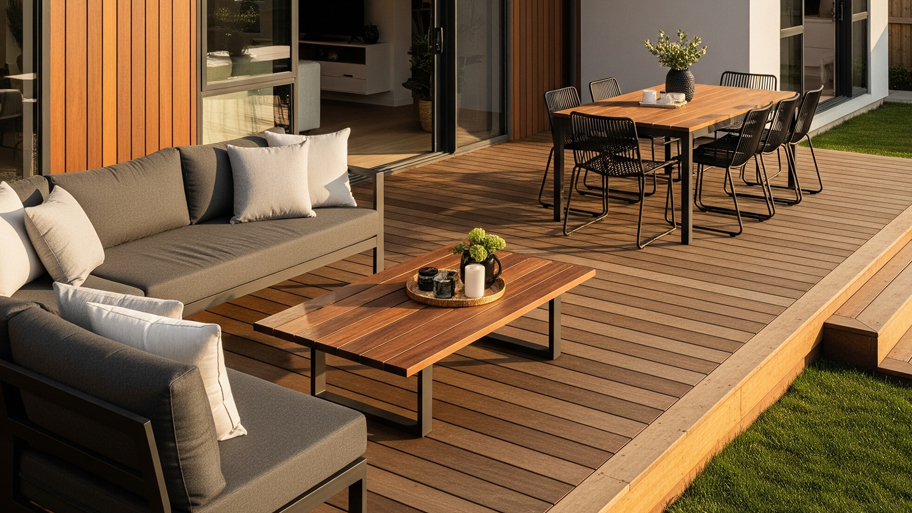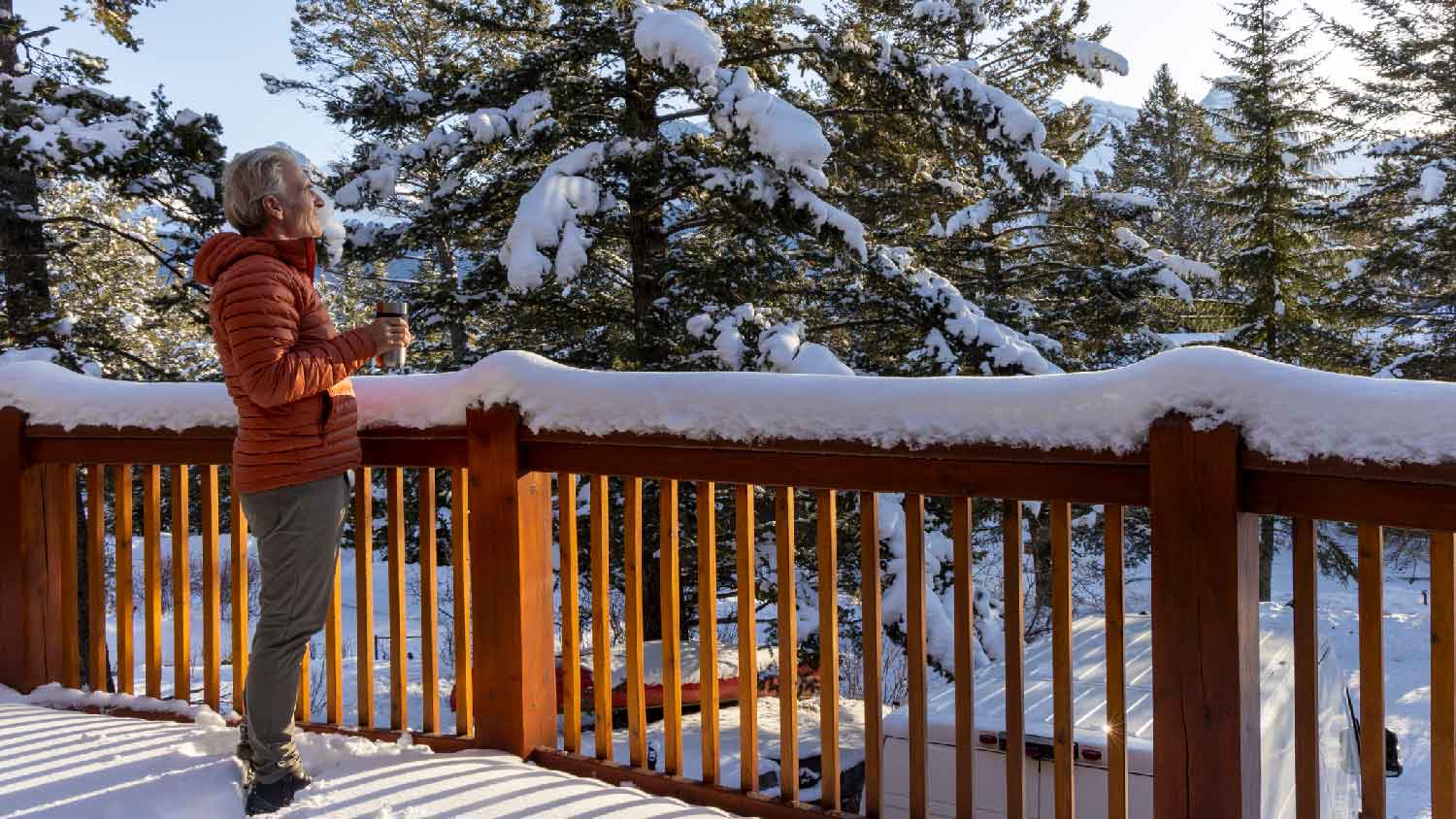
Vinyl is a durable and relatively inexpensive choice of decking material. Your vinyl deck cost will depend on labor, the deck size, and more.
Take it slow on a lanai patio


“Lanai” is a Hawaiian word for a covered patio.
A lanai extends outdoors from an existing room.
Lanais sometimes contain a swimming pool.
A lanai can count toward a home’s total square footage.
If you love watching the birds as you sip your morning coffee, or savor the smell of a fresh afternoon breeze—but value privacy—a lanai can turn your home into a paradise. Add an inground pool to your lanai, and you’re living in a dreamy oasis.
“Lanai” is a Hawaiian word for a covered patio. Just saying it inspires images of palm trees, sandals, and sunshine. But people often confuse lanais with verandas or covered porches. A lanai has a different structure and design that sets it apart from other enclosed outdoor areas.
Lanais are popular in Hawaii and other warm regions like Florida and Southern California, as they offer shade, privacy, protection from the elements, and (usually) year-round use. But not all covered patios or porches are lanais.
Let’s take a look at how lanais stand out from other outdoor areas.
A porch is a covered area that’s attached to the outside of a home or building. A lanai is different in that it extends out from an existing room, with access via French doors or sliding glass doors. A porch is typically in front of a home, while a lanai extends out from the back or the side.
A veranda connects to an entire side of a home or building and features a railing enclosure. It might cover more than one side of a home, like a wraparound porch.
A patio is an outdoor area that is either covered or uncovered. Its main feature is hard flooring, be it concrete, pavers, or some other type of hardscape. A lanai also has hard flooring—it might even be the same type of flooring that’s in the room from which it extends.
Lanais tend to be larger than other outdoor areas. In regions with year-round pool weather, it’s common for a large lanai to contain an indoor swimming pool. Screens or glass pool enclosures often cover lanais to keep out bugs, critters, and UV rays.
The main difference between a lanai and a patio is that a lanai is enclosed. Patios can be either covered or uncovered, but they are rarely enclosed. Many homeowners choose a lanai to keep insects out so they can enjoy fresh outdoor air bug-free. Patios don’t come with this built-in purpose and act more like a basic extension of your indoor space into the outdoors.
When deciding if you should install a lanai, it’s important to weigh the benefits and drawbacks.
Insect-proofing: Lanais insect-proof your outdoor space so you can enjoy the fresh air without visits from mosquitoes, hornets, wasps, or any other pests.
Privacy: Lanais always come with a roof and at least one wall, ensuring you can relax in the comfort of the outdoors without worrying about anyone peeking in.
All-season usage: Lanais are common in sunny climates like Florida, California, and Hawaii, but the protection they offer from the elements means you can use them in other climates, too.
Distance from outdoors: Sitting on a patio is a more direct experience with the outdoors than sitting on a lanai. With so much more protection from the elements, you may feel disconnected from the nature around you.
Maintenance required: Most of the time, an outdoor space only requires maintenance occasionally due to inclement weather. A lanai, on the other hand, comes with windows and screens that require regular upkeep and cleaning.

If you enjoy relaxing or entertaining outdoors, a lanai could be a valuable addition to your home. Not only will you get to experience the perks of an at-home oasis, you’ll likely benefit from its added value if you decide to sell your house. Many buyers are eager to snag a home that offers the luxury of a lanai.
Keep in mind that a lanai will usually only count toward your home’s square footage if it fulfills two criteria:
It’s heated or cooled by the home’s main HVAC system
It has the same roof or flooring as the room from which it extends
A screened-in sunroom might have similar benefits to a lanai, but if it is attached to the home, it cannot be considered part of the home’s square footage. This will matter when your home is appraised, as the liveable square footage will influence the sale price.
Building a lanai is a big undertaking that is best left to a lanai installation professional. A local pro can answer any questions you have to get the ball rolling on your indoor-outdoor oasis.
Building a lanai with a screened enclosure costs between $1,200 and $1,600, or about $6 to $8 per square foot. As with many other home improvement projects, the cost to build a lanai depends on the size of the space, plus labor and materials. For example, if you choose high-end pavers for the surface of your lanai, you will likely pay more for the project.
A lanai is like an additional room in your house. You’ll need a professional to build it, especially if you’re starting from scratch and need to install walls and flooring. A pro will ensure the measurements are correct and levels perfectly straight. Talk to a local porch pro about the project and what to expect.
From average costs to expert advice, get all the answers you need to get your job done.

Vinyl is a durable and relatively inexpensive choice of decking material. Your vinyl deck cost will depend on labor, the deck size, and more.

If you’re updating a deck or staircase with a modern railing, you may be wondering how much cable railing costs. We dive into the cost factors you need to know.
Deck repair costs depend on materials, damage you need to fix, and more. See how much it costs to replace or repair a deck in Columbus, OH.

Lattice panels can give your home a polished look and hidden storage. Learn how to install lattice under a deck or porch with this step-by-step guide.

Outdoor living structures such as porches, stoops, decks, and patios are all common ways to make your house stand out. Here’s the difference between the four types of structures and what to consider when building one for your home.

Learning how to winterize a deck can protect your outdoor space from harsh weather. Here’s how to do it properly so you can enjoy a fresh deck next summer.